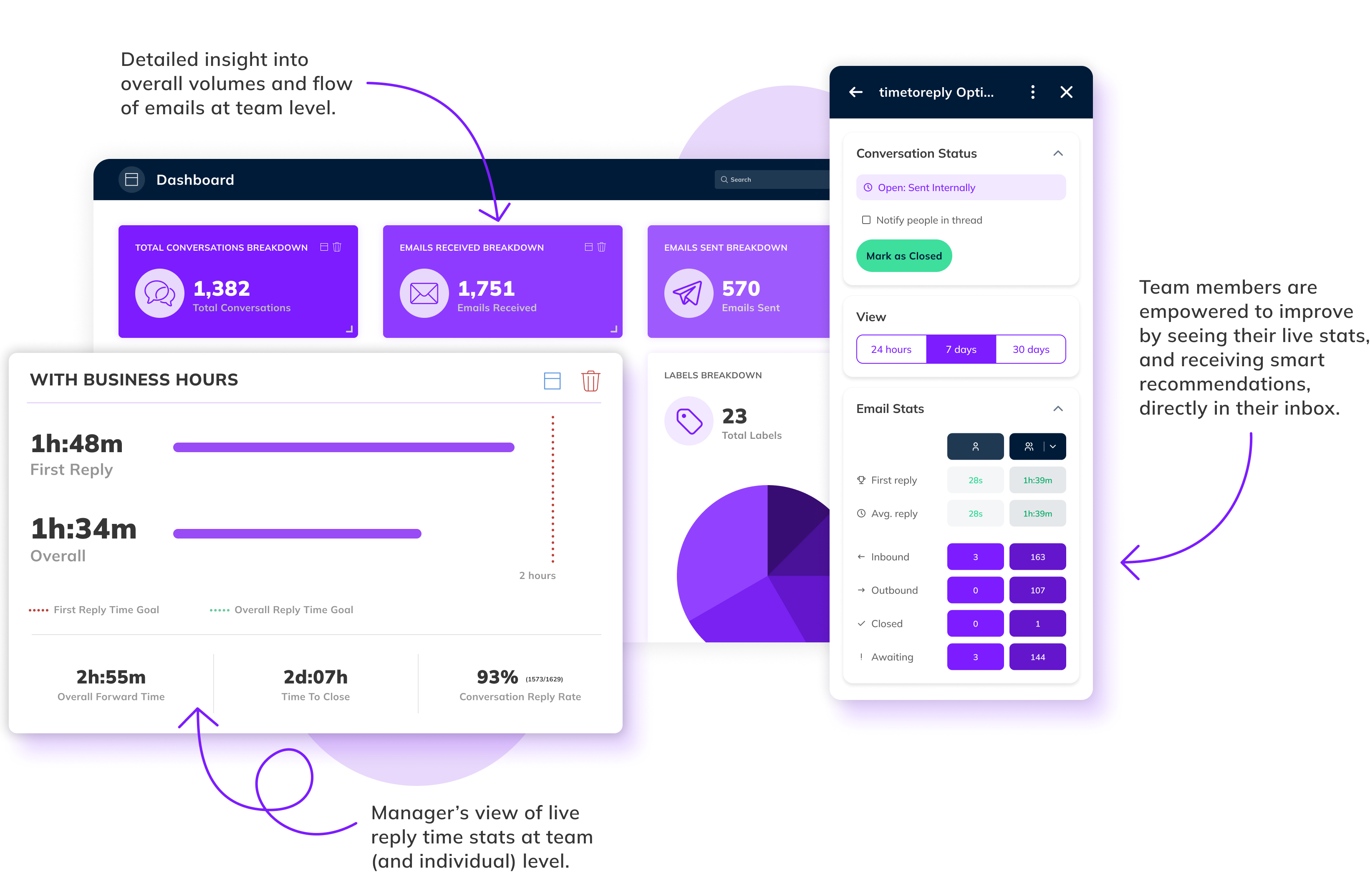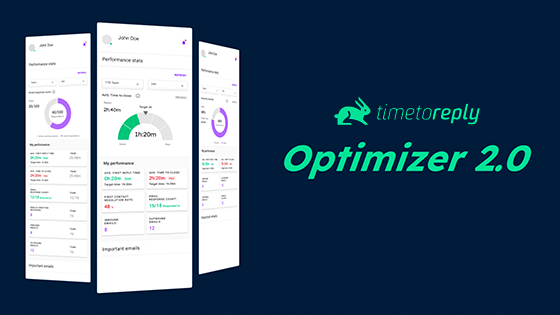A Shared mailbox address is an email address that looks like support@, contact@, talkto@, etc. This kind of email address is usually accessed by several people in a team. Anyone with credentials can ‘log in’ and respond to a query which is great when first establishing an email customer service process.
However, as your business grows, you’ll need to implement some shared mailbox best practices that ensure that your customers and leads are kept happy and that there is no disparity in your email reply times.
Shared mailboxes are just like individual mailboxes with only one key difference – it can be used by multiple members of a team simultaneously if they are invited by an administrator. Unlike shared passwords, shared mailboxes are safe to use, secure, and acts as a centralized platform for teams to get a singular view on customer communication.
That said, one of the key problems with shared mailboxes is the inability to measure performance and track accountability. Companies usually do not have an organized way to go about managing shared mailboxes which makes it difficult to make efficient use of a centralized solution.
But what if companies could track the individual performance of team members assigned to a shared inbox? What if they were able to measure the response time of each individual to customer queries?
Not only will these metrics solve the performance measurement problem, but it will also allow teams to stay organized, increase response time, and positive customer ratings.
Here’s how teams can achieve these key goals with timetoreply.
As an email response time measuring solution, timetoreply enables users to measure accounts in the shared mailbox.
Users can connect the main inbox and map the individual accounts of all teammates accessing the inbox. With this ability, administrators or managers can measure performance on an individual level within the inbox. Multiple shared inboxes from multiple departments (such as sales, PR, support, marketing, etc) can be measured simultaneously within the timetoreply platform. All you have to do is add the shared inbox account and the assigned individual accounts to begin getting extensive reports on response time.

As you can see in the above report, timetoreply gives you a view of your team’s shared mailbox, but with the added feature of seeing exactly how each team member performs within the shared mailbox. That way, you can see exactly who’s doing the lion share of the work, who isn’t very active within the mailbox, who replies quickly, and who needs to pick up the pace.
timetoreply also allows you to see, in one visual dashboard, how many emails are in a shared mailbox, how many emails are waiting for a reply, and how many emails haven’t had a first reply.
You can toggle the filters to see the stats for a shared mailbox when communicating with external emails only, internal emails only, specific customer groups, or anyone, making it very easy to prioritize the emails your support or sales team needs to be on top of.
As companies grow, so do customer demands and expectations. People want instant answers to their queries, and companies that cannot deliver a helpful, prompt response time within 12 hours of the query will lose the customer. How well and how soon a sales rep answers the customer is directly proportional to customer satisfaction.
It is safe to say that if a sales rep ignores a customer query, they are directly responsible for revenue loss. If a sales rep delivers optimal performance, they are responsible for positive reviews and ratings, making them eligible for rewards and incentives in the organization.
How would you know which of your team members are doing well if you can’t track them? That too is in a shared inbox that has no traceability.
timetoreply resolves this key problem by letting managers see the total number of emails, and the average response time of each sales/customer service rep on a daily, weekly, and monthly basis. With this insight, it is easier for an organization to identify and reward key performers in a fair & factual manner, and to hold them accountable to a visible, measurable set of KPIs.
Valid question!
In some companies, queries posted to a generic account are answered by a chatbot, while the query gets redirected to a team member. The reps then contact the customer on a one-to-one basis. In case the rep is not able to provide the right response, they then have to forward the email to other teams. This to-and-fro of communication can cause significant delays in resolving a query.
Moreover, this can also cause teams to have a disjointed view of the problem, resulting in a frustrating experience for the user.
If organizations had an efficient response time performance tracker in place, shared inboxes deliver far many benefits compared to individual emails.
With unified access, your teams can collaborate with ease and work quickly to resolve a problem rather than getting entangled in process complications.
For instance, forwarding and responding to chain emails results in unclear communication, loss of valuable time & a frustrating experience for everyone involved. With a shared inbox, you won’t need to forward emails. Teammates can easily coordinate and decide who should take on the query.
The most important benefit though is that you can measure the team’s performance as a whole and identify process gaps that need to be addressed immediately.
The best way to reduce team conflicts is by ensuring transparency and visibility. Everyone in the team can see how everyone else is performing to respond to the customer and resolve problems in record time. This kind of transparency pushes even the most laid-back performer to make an effort to perform. Appraisals, incentives, and rewards for best performance will be backed by actual data rather than on a manager’s evaluation.
Companies spend millions of dollars trying to understand the challenges their customers face. With a shared inbox though, everything you ever wanted to know about your customers’ problems, their challenges, gaps in your services, or flaws in your product is all available in one central platform.
This treasure trove of knowledge can be used by marketing teams to create relevant content, by the PR team to craft convincing messages and by the support team to create FAQs or user guides.
Most importantly, it is also great in helping new team members understanding communication, challenges, and problem-solving without having to rely on manual instructions from anyone else.
Do you have templates that team members can use? Or a guide to help support pros solve complicated but common issues? Without the proper documentation outside of your shared mailbox, customer service pros are much less likely to be able to help people inside of it.
Make sure to record processes for people to reference in a shared private space, such as Google Docs, or Dropbox. This extra step can help with onboarding and integrating new team members into a shared mailbox workflow.
As you problem solve, make sure to record the most common queries and responses for future usage.
Within Gmail, they’re called “labels,” although they serve a parallel purpose to folders in other email providers. These organizers offer a clear way to sort the flow of emails coming in on any given day. Use folders to organize emails by topic. Let’s say you have a folder for each common topic and one for miscellaneous issues; you can track the volume of each kind of issue.
With timetoreply, you can even report on your labels, making them even more useful.
Trust between a company and a customer is fragile. Once you break trust, it’s hard to earn it back. So you need to ensure that your team is getting back to each and every customer email, and in a timely manner.
Even one message that slips through the cracks can be the turning point in a customer relationship. The bigger your backlog, the more and more likely that is to happen. If you work toward reaching inbox zero every day, you’re aiming for prompt responses and quick resolutions.
Shared inboxes make it easier to help your teams stay aligned and focus on what truly matters – resolving customer queries on time, every time. But merely having an inbox is not enough. Your team’s performance within a centralized eco-system must be measured to ensure transparency & visibility. Without a measurement system in place, it will be difficult to stay organized, rendering a shared inbox ineffective.
Do you want to experience the power of timetoreply for yourself? Schedule a demo now and discover the future of elevated communication strategies!



Trusted by high-performing inbound sales teams and customer-facing teams globally.
Close more deals and delight more customers with the faster, smarter, deeper email analytics and performance optimization software that works straight from your team’s inbox.